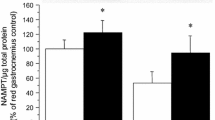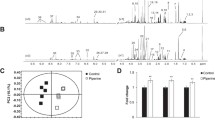Abstract
Purpose
Creatine uptake by muscle cells is increased in the presence of insulin. Accordingly, compounds with insulin-like actions may also augment creatine uptake. The aim of this study was to investigate whether Trigonella foenum-graecum (fenugreek), an insulin mimetic, increases total intracellular creatine levels in vitro.
Methods
Total cellular creatine content was measured fluorometrically in L6C11 muscle myotubes treated for 1, 4, and 24 h with 0.5 mM creatine (CR), CR and 20 μg/mL fenugreek seed extract (CR + FEN), CR and 100 nM insulin (CR + INS), and CR + INS + FEN (n = 6 per treatment group). Alterations in the expression of the sodium- and chloride-dependent creatine transporter, SLC6A8, and key signaling proteins in the PI3-K/Akt pathway were determined.
Results
Compared to control (CON), CR + INS + FEN increased total creatine content after 4 h (P < 0.05), whereas all conditions increased SLC6A8 protein expression above CON at this time (P < 0.05). Changes in insulin signaling were demonstrated via increases in AktThr308 phosphorylation, with CR + INS > CON and CR at 1 h (P < 0.05) and with CR + INS + FEN > CON, CR, and CR + INS at 4 h (P < 0.05). In contrast, no changes in PKCζ/λ or GLUT4 phosphorylation were detected.
Conclusion
Fenugreek, when combined with insulin, modulates creatine content via a mechanism which is independent of the activity of SLC6A8, suggesting that an alternative mechanism is responsible for the regulation and facilitation of insulin-mediated creatine uptake in skeletal muscle cells.




Similar content being viewed by others
References
Greenhaff PL (2001) The creatine-phosphocreatine system: there’s more than one song in its repertoire. J Physiol 537(3):657
Wallimann T, Wyss M, Brdiczka D, Nicolay K, Eppenberger HM (1992) Intracellular compartmentation, structure and function of creatine kinase isoenzymes in tissues with high and fluctuating energy demands: the ‘phosphocreatine circuit’ for cellular energy homeostasis. Biochem J 281(Pt 1):21–40
Harris RC, Soderlund K, Hultman E (1992) Elevation of creatine in resting and exercised muscle of normal subjects by creatine supplementation. Clin Sci 83(3):367–374
Greenhaff PL, Bodin K, Soderlund K, Hultman E (1994) Effect of oral creatine supplementation on skeletal muscle phosphocreatine resynthesis. Am J Physiol 266(5 Pt 1):E725–E730
Green AL, Hultman E, Macdonald IA, Sewell DA, Greenhaff PL (1996) Carbohydrate ingestion augments skeletal muscle creatine accumulation during creatine supplementation in humans. Am J Physiol 271(5 Pt 1):E821–E826
Odoom JE, Kemp GJ, Radda GK (1996) The regulation of total creatine content in a myoblast cell line. Mol Cell Biochem 158(2):179–188
Loike JD, Zalutsky DL, Kaback E, Miranda AF, Silverstein SC (1988) Extracellular creatine regulates creatine transport in rat and human muscle cells. PNAS 85(3):807–811
Walker JB (1979) Creatine: biosynthesis, regulation, and function. Adv Enzymol Relat Areas Mol Biol 50:177–242
Kingsley M, Cunningham D, Mason L, Kilduff LP, McEneny J (2009) Role of creatine supplementation on exercise-induced cardiovascular function and oxidative stress. Oxid Med Cell Longev 2(4):247–254
Schoch RD, Willoughby D, Greenwood M (2006) The regulation and expression of the creatine transporter: a brief review of creatine supplementation in humans and animals. J Int Soc Sports Nutr 3(1):60–66
Balsom P, Harridge S, Soderlund K, Sjodin B, Ekblom B (1993) Creatine supplementation per se does not enhance endurance exercise performance. Acta Physiol Scand 149(4):521–523
Jager R, Purpura M, Shao A, Inoue T, Kreider RB (2011) Analysis of the efficacy, safety, and regulatory status of novel forms of creatine. Amino Acids 40(5):1369–1383
Persky AM, Brazeau GA, Hochhaus G (2003) Pharmacokinetics of the dietary supplement creatine. Clin Pharmacokinet 42(6):557–574
Snow RJ, Murphy RM (2003) Factors influencing creatine loading into human skeletal muscle. Exerc Sport Sci Rev 31(3):154–158
Snow RJ, Murphy RM (2001) Creatine and the creatine transporter: a review. Mol Cell Biochem 224(1–2):169–181
Loike JD, Somes M, Silverstein SC (1986) Creatine uptake, metabolism, and efflux in human monocytes and macrophages. Am J Physiol Cell Physiol 251(1):C128–C135
Willott C, Young M, Leighton B, Kemp G, Boehm E, Radda G, Clarke K (1999) Creatine uptake in isolated soleus muscle: kinetics and dependence on sodium, but not on insulin. Acta Physiol Scand 166(2):99–104
Murphy R, McConell G, Cameron-Smith D, Watt K, Ackland L, Walzel B, Wallimann T, Snow R (2001) Creatine transporter protein content, localization, and gene expression in rat skeletal muscle. Am J Physiol Cell Physiol 280(3):C415–C422
Steenge G, Lambourne J, Casey A, Macdonald I, Greenhaff P (1998) Stimulatory effect of insulin on creatine accumulation in human skeletal muscle. Am J Physiol Endocrinol Metab 275(6):E974–E979
Steenge G, Simpson E, Greenhaff P (2000) Protein-and carbohydrate-induced augmentation of whole body creatine retention in humans. J Appl Physiol 89(3):1165–1171
Haugland RB, Chang DT (1975) Insulin effect on creatine transport in skeletal muscle. Exp Biol Med (Maywood) 148:1–4
Koszalka TR, Andrew CL (1972) Effect of insulin on the uptake of creatine-1-14C by skeletal muscle in normal and X-irradiated rats. Exp Biol Med (Maywood) 139:1265–1271
Smith M (2003) Therapeutic applications of fenugreek. Altern Med Rev 8(1):20–27
Kang LPZY, Pang X, Yu HS, Xiong CQ, Zhang J, Gao Y, Yu K, Ma BP (2013) Characterization and identification of steroidal saponins from the seeds of Trigonalla foem-graecum by ultra high-performance liquid chromatography and hybrid time-of-flight mas spectrometry. J Pharm Biomed Anal 23(74):11
Al-Jasass FM, Al-Jasser MS (2012) Chemical composition and fatty acid content of some spices and herbs under Saudi Arabia conditions. Sci World J 2012:1–5
Sauvaire Y, Petit P, Broca C, Manteghetti M, Baissac Y, Fernandez-Alvarez J, Gross R, Roye M, Leconte A, Gomis R (1998) 4-Hydroxyisoleucine: a novel amino acid potentiator of insulin secretion. Diabetes 47(2):206–210
Narender T, Puri A, Khaliq T, Saxena R, Bhatia G, Chandra R (2006) 4-Hydroxyisoleucine an unusual amino acid as antidyslipidemic and antihyperglycemic agent. Bioorg Med Chem Lett 16(2):293–296
Kenny O, Smyth T, Hewage C, Brunton N (2013) Antioxidant properties and quantitative UPLC-MS analysis of phenolic compounds from extracts of fenugreek Trigonella foenum-graecum seeds and bitter melon Momordica charantia fruit. Food Chem 141(4):4295–4302
Nathan J, Panjwani S, Mohan V, Joshi V, Thakurdesai PA (2013) Efficacy and safety of standardized extract of Trigonella foenum‐graecum L seeds as an adjuvant to L‐dopa in the management of patients with Parkinson’s disease. Phytother Res 28(2):172–178
Srinivasan K (2006) Fenugreek (Trigonella foenum-graecum): a review of health beneficial physiological effects. Food Rev Int 22(2):203–224
Jaiswal N, Maurya CK, Venkateswarlu K, Sukanya P, Srivastava AK, Narender T, Tamrakar AK (2012) 4-Hydroxyisoleucine stimulates glucose uptake by increasing surface GLUT4 level in skeletal muscle cells via phosphatidylinositol-3-kinase-dependent pathway. Eur J Nutr 51(7):893–898
Vijayakumar MV, Singh S, Chhipa RR, Bhat MK (2005) The hypoglycaemic activity of fenugreek seed extract is mediated through the stimulation of an insulin signalling pathway. Br J Pharmacol 146(1):41–48
Broca C, Breil V, Cruciani-Guglielmacci C, Manteghetti M, Rouault C, Derouet M, Rizkalla S, Pau B, Petit P, Ribes G (2004) Insulinotropic agent ID-1101 (4-hydroxyisoleucine) activates insulin signaling in rat. Am J Physiol Endocrinol Metab 287(3):E463–E471
Conn RB (1960) Fluorimetric determination of creatine. Clin Chem 6(6):537–548
Camera DM, West DW, Burd NA, Phillips SM, Garnham AP, Hawley JA, Coffey VG (2012) Low muscle glycogen concentration does not suppress the anabolic response to resistance exercise. J Appl Physiol 113(2):206–214
Greenhaff PL (1996) Creatine supplementation: recent developments. Br J Sports Med 30(4):276–277
Ceddia RB, Sweeney G (2004) Creatine supplementation increases glucose oxidation and AMPK phosphorylation and reduces lactate production in L6 rat skeletal muscle cells. J Physiol 555(2):409–421
Sora I, Richman J, Santoro G, Wei H, Wang Y, Vanderah T, Horvath R, Nguyen M, Waite S, Roeske WR (1994) The cloning and expression of a human creatine transporter. Biochem Biophys Res Commun 204(1):419–427
Ogawa J, Kodera T, Smirnov SV, Hibi M, Samsonova NN, Koyama R, Yamanaka H, Mano J, Kawashima T, Yokozeki K (2011) A novel l-isoleucine metabolism in Bacillus thuringiensis generating (2S, 3R, 4S)-4-hydroxyisoleucine, a potential insulinotropic and anti-obesity amino acid. Appl Microbiol Biotechnol 89(6):1929–1938
Shabbeer S, Sobolewski M, Anchoori RK, Kachhap S, Hidalgo M, Jimeno A, Davidson NE, Carducci M, Khan SR (2009) Fenugreek: a naturally occurring edible spice as an anticancer agent. Cancer Biol Ther 8(3):272–278
Taylor L, Poole C, Pena E, Lewing M, Kreider R, Foster C, Wilborn C (2011) Effects of combined creatine plus fenugreek extract vs. creatine plus carbohydrate supplementation on resistance training adaptations. J Sports Sci Med 10(2):254–260
Daly MM, Seifter S (1980) Uptake of creatine by cultured cells. Arch Biochem Biophys 203(1):317–324
Almilaji A, Sopjani M, Elvira B, Borras J, Dermaku-Sopjani M, Munoz C, Warsi J, Lang UE, Lang F (2014) Upregulation of the creatine transporter Slc6A8 by Klotho. Kidney Blood Press Res 39(6):516–525
Oldham S, Hafen E (2003) Insulin/IGF and target of rapamycin signaling: a TOR de force in growth control. Trends Cell Biol 13(2):79–85
Kim Y-B, Nikoulina SE, Ciaraldi TP, Henry RR, Kahn BB (1999) Normal insulin-dependent activation of Akt/protein kinase B, with diminished activation of phosphoinositide 3-kinase, in muscle in type 2 diabetes. J Clin Invest 104(6):733–741
Deldicque L, Atherton P, Patel R, Theisen D, Nielens H, Rennie MJ, Francaux M (2008) Effects of resistance exercise with and without creatine supplementation on gene expression and cell signaling in human skeletal muscle. J Appl Physiol 104(2):371–378
Acknowledgments
The authors of this paper would like to thank A/Prof. Theo Macrides and the RMIT Natural Products Research Group (Dr. Lynn Hodges, Mr. Donald Harney, and Ms. Nicolette Kalafatis) as well as Mr. Robert Brkljaca for their invaluable help in the extraction process. We appreciate and thank Mr. Frank Antolasic for the analysis of the fenugreek extract samples. Additionally, we would like to thank Mr. Griffin D’costa for his input and valuable discussions about fenugreek and cell culture technique.
Author information
Authors and Affiliations
Corresponding author
Ethics declarations
Conflict of interest
On behalf of all authors, the corresponding author states that there is no conflict of interest.
Electronic supplementary material
Below is the link to the electronic supplementary material.

Figure 1
A liquid chromatography-mass spectroscopy (LC-MS) method was developed and validated for the analysis of (2S,3R,4S)- 4-hydroxyisoleucine (4-HIL) in fenugreek seed extract. A- A representative analytical scale of separation and abundance for fenugreek seed extract run on an Electrospray Ionization ESI mass spectrometer. Extract analysis was performed by monitoring the area under the 4-HIL peak at mass/charge of 148 which corresponds to the [4HIL+1] parent ion in the mass spectrum in each extract sample. B- A comparison of the percentage of 4-HIL per extract by weight. A calibration curve was created from 4-HIL standards and fenugreek extract 4-HIL samples. The weight of the 4-HIL content from each fenugreek extract sample was determined using area under the curve and calculated as a percentage. (JPEG 62 kb)
Rights and permissions
About this article
Cite this article
Tomcik, K.A., Smiles, W.J., Camera, D.M. et al. Fenugreek increases insulin-stimulated creatine content in L6C11 muscle myotubes. Eur J Nutr 56, 973–979 (2017). https://doi.org/10.1007/s00394-015-1145-1
Received:
Accepted:
Published:
Issue Date:
DOI: https://doi.org/10.1007/s00394-015-1145-1




